University Nursing Report: Clinical Reasoning and Patient Management
VerifiedAdded on 2021/04/17
|13
|2927
|36
Report
AI Summary
This nursing assignment analyzes the clinical reasoning process in the care of a 79-year-old patient, Mrs. Kate Ham, who underwent a right total knee arthroplasty (RTKA). The assignment focuses on the application of the DETECT framework (Detect, Evaluate, Treatment, Escalate, Communicate, Teams) to assess the patient's condition, identify potential complications such as pain, neurovascular issues, and hypoglycemia, and implement appropriate nursing interventions. The report details the nursing assessment, including monitoring pain levels, neurovascular status, and blood glucose. It explains the rationale behind clinical decisions, such as managing post-operative pain, preventing neurovascular damage, and addressing tachycardia. The assignment emphasizes the importance of communication within the healthcare team, using the ISBAR tool for clear and concise handover information. The analysis highlights the critical role of clinical reasoning and evaluation of patient outcomes in providing safe and high-quality care, particularly for patients with co-morbidities like asthma and NIDDM. The assignment also explores the importance of early recognition of complications, such as venous thromboembolism, and the necessity for timely escalation of concerns to the surgical team. The report concludes by emphasizing the need for regular patient assessment and the application of nursing knowledge in making the best decisions for the patient's well-being.
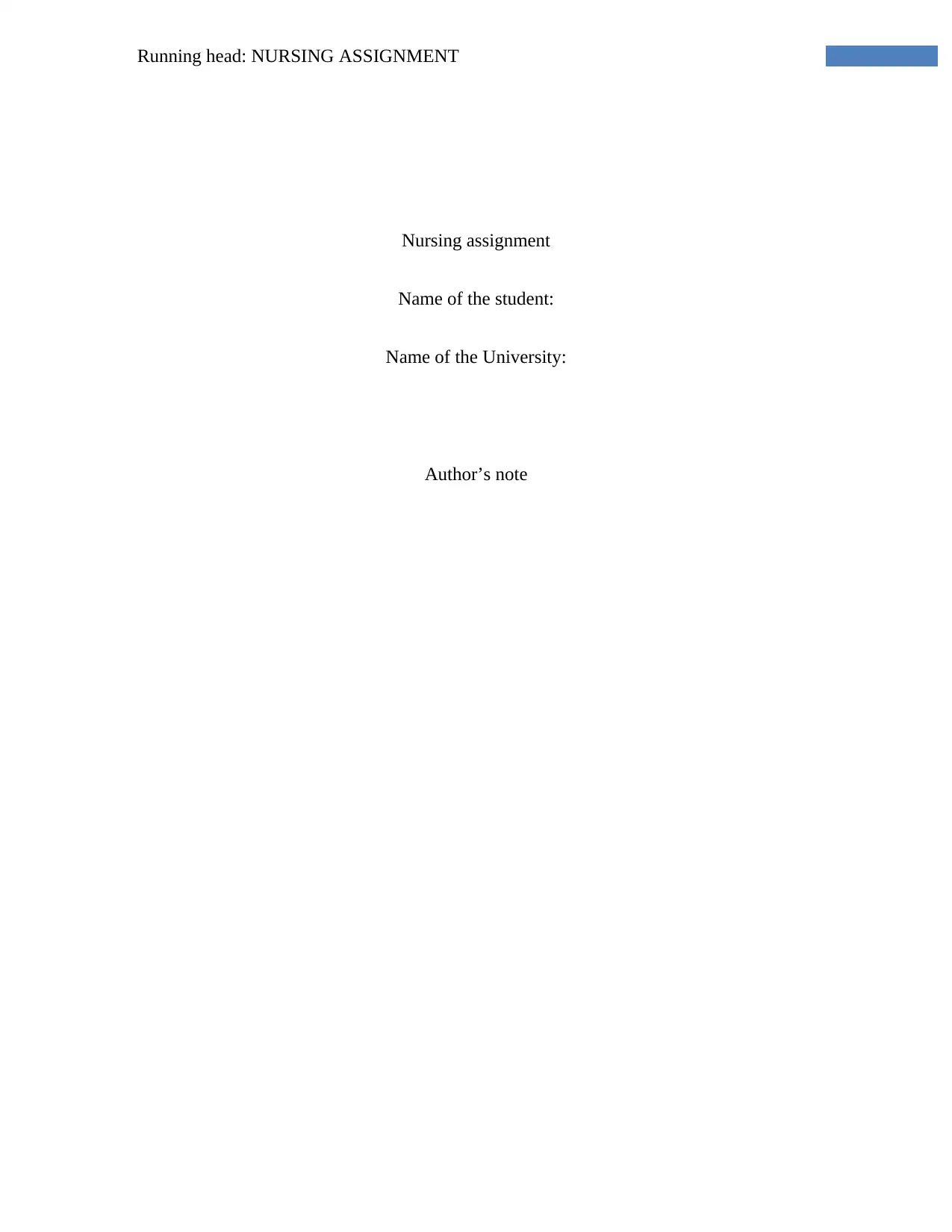
Running head: NURSING ASSIGNMENT
Nursing assignment
Name of the student:
Name of the University:
Author’s note
Nursing assignment
Name of the student:
Name of the University:
Author’s note
Paraphrase This Document
Need a fresh take? Get an instant paraphrase of this document with our AI Paraphraser
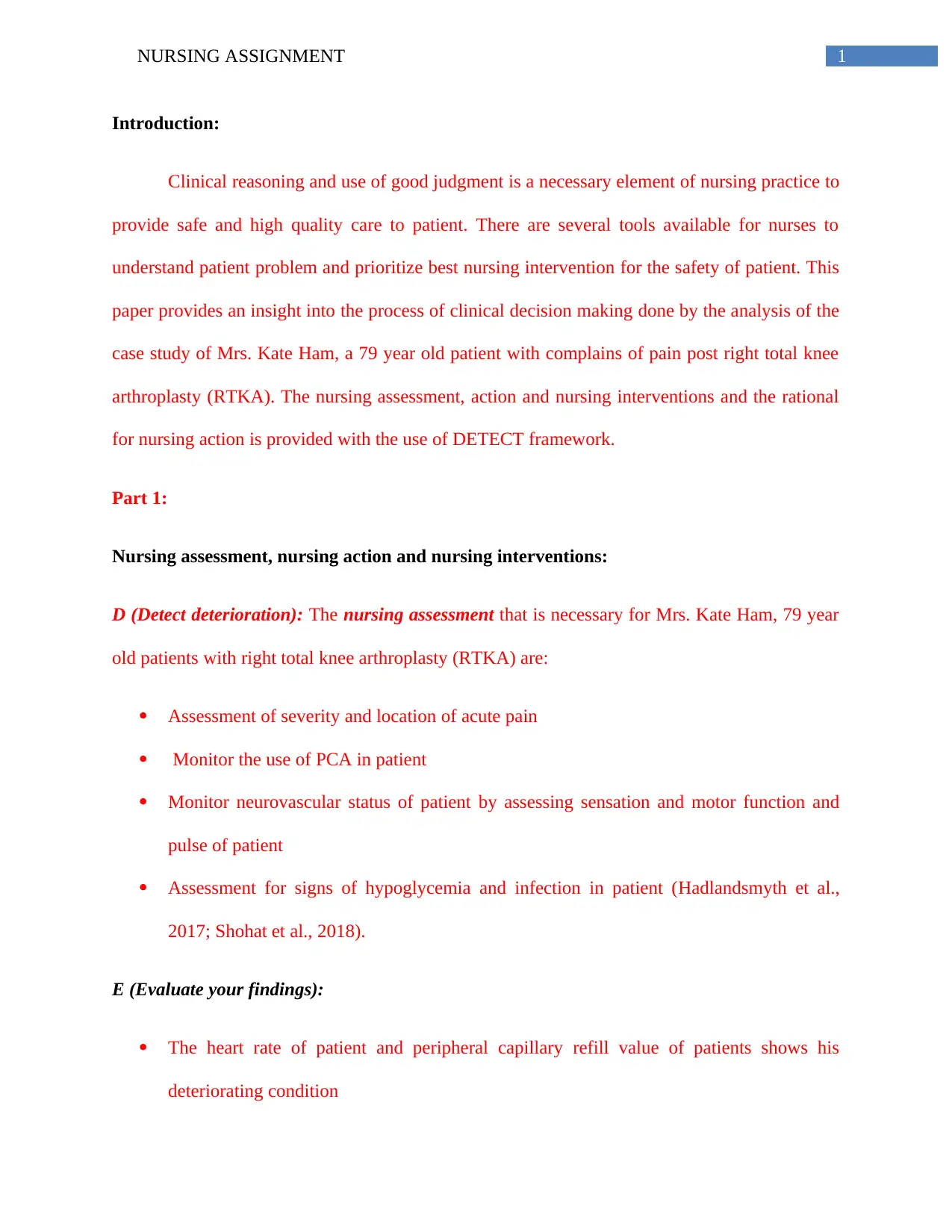
1NURSING ASSIGNMENT
Introduction:
Clinical reasoning and use of good judgment is a necessary element of nursing practice to
provide safe and high quality care to patient. There are several tools available for nurses to
understand patient problem and prioritize best nursing intervention for the safety of patient. This
paper provides an insight into the process of clinical decision making done by the analysis of the
case study of Mrs. Kate Ham, a 79 year old patient with complains of pain post right total knee
arthroplasty (RTKA). The nursing assessment, action and nursing interventions and the rational
for nursing action is provided with the use of DETECT framework.
Part 1:
Nursing assessment, nursing action and nursing interventions:
D (Detect deterioration): The nursing assessment that is necessary for Mrs. Kate Ham, 79 year
old patients with right total knee arthroplasty (RTKA) are:
Assessment of severity and location of acute pain
Monitor the use of PCA in patient
Monitor neurovascular status of patient by assessing sensation and motor function and
pulse of patient
Assessment for signs of hypoglycemia and infection in patient (Hadlandsmyth et al.,
2017; Shohat et al., 2018).
E (Evaluate your findings):
The heart rate of patient and peripheral capillary refill value of patients shows his
deteriorating condition
Introduction:
Clinical reasoning and use of good judgment is a necessary element of nursing practice to
provide safe and high quality care to patient. There are several tools available for nurses to
understand patient problem and prioritize best nursing intervention for the safety of patient. This
paper provides an insight into the process of clinical decision making done by the analysis of the
case study of Mrs. Kate Ham, a 79 year old patient with complains of pain post right total knee
arthroplasty (RTKA). The nursing assessment, action and nursing interventions and the rational
for nursing action is provided with the use of DETECT framework.
Part 1:
Nursing assessment, nursing action and nursing interventions:
D (Detect deterioration): The nursing assessment that is necessary for Mrs. Kate Ham, 79 year
old patients with right total knee arthroplasty (RTKA) are:
Assessment of severity and location of acute pain
Monitor the use of PCA in patient
Monitor neurovascular status of patient by assessing sensation and motor function and
pulse of patient
Assessment for signs of hypoglycemia and infection in patient (Hadlandsmyth et al.,
2017; Shohat et al., 2018).
E (Evaluate your findings):
The heart rate of patient and peripheral capillary refill value of patients shows his
deteriorating condition
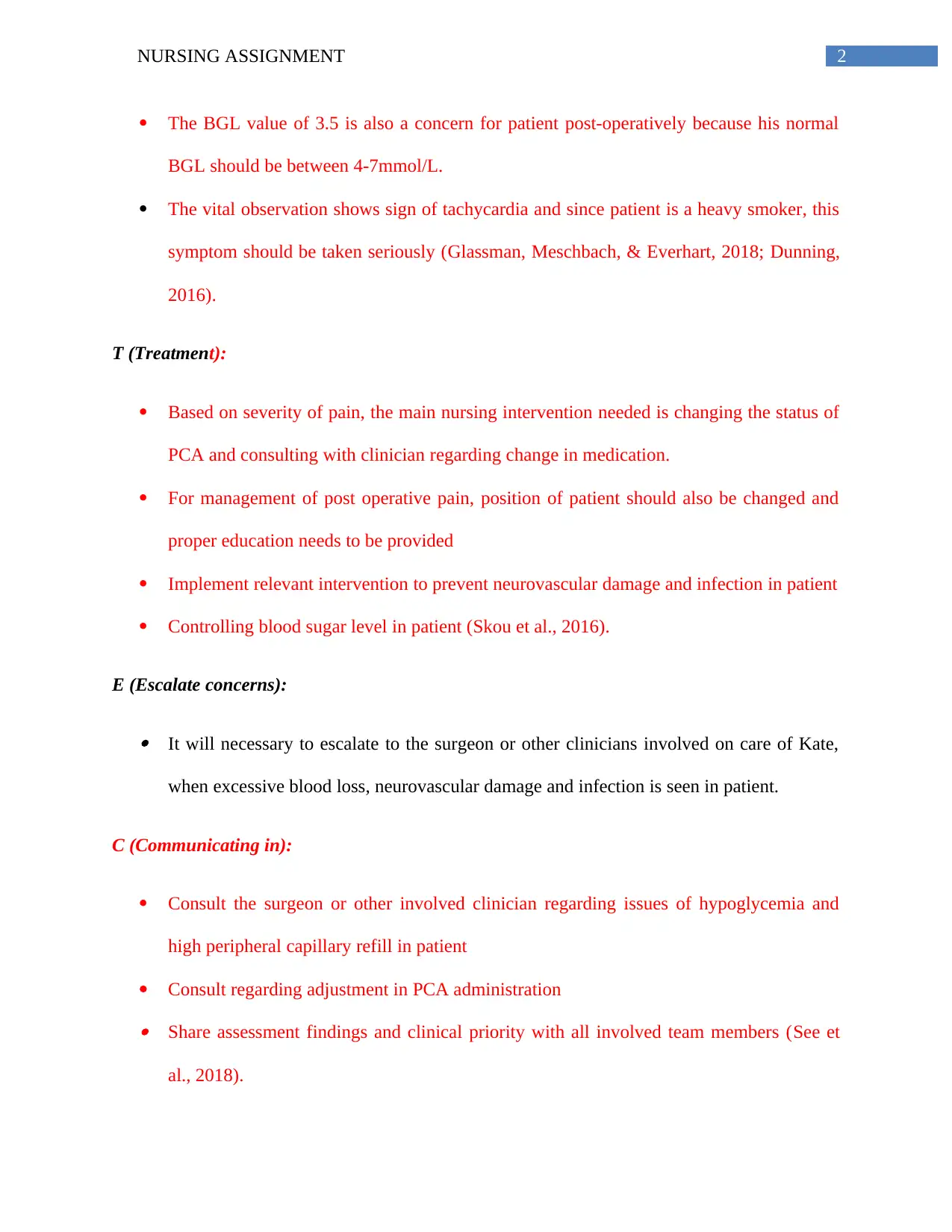
2NURSING ASSIGNMENT
The BGL value of 3.5 is also a concern for patient post-operatively because his normal
BGL should be between 4-7mmol/L.
The vital observation shows sign of tachycardia and since patient is a heavy smoker, this
symptom should be taken seriously (Glassman, Meschbach, & Everhart, 2018; Dunning,
2016).
T (Treatment):
Based on severity of pain, the main nursing intervention needed is changing the status of
PCA and consulting with clinician regarding change in medication.
For management of post operative pain, position of patient should also be changed and
proper education needs to be provided
Implement relevant intervention to prevent neurovascular damage and infection in patient
Controlling blood sugar level in patient (Skou et al., 2016).
E (Escalate concerns):
It will necessary to escalate to the surgeon or other clinicians involved on care of Kate,
when excessive blood loss, neurovascular damage and infection is seen in patient.
C (Communicating in):
Consult the surgeon or other involved clinician regarding issues of hypoglycemia and
high peripheral capillary refill in patient
Consult regarding adjustment in PCA administration Share assessment findings and clinical priority with all involved team members (See et
al., 2018).
The BGL value of 3.5 is also a concern for patient post-operatively because his normal
BGL should be between 4-7mmol/L.
The vital observation shows sign of tachycardia and since patient is a heavy smoker, this
symptom should be taken seriously (Glassman, Meschbach, & Everhart, 2018; Dunning,
2016).
T (Treatment):
Based on severity of pain, the main nursing intervention needed is changing the status of
PCA and consulting with clinician regarding change in medication.
For management of post operative pain, position of patient should also be changed and
proper education needs to be provided
Implement relevant intervention to prevent neurovascular damage and infection in patient
Controlling blood sugar level in patient (Skou et al., 2016).
E (Escalate concerns):
It will necessary to escalate to the surgeon or other clinicians involved on care of Kate,
when excessive blood loss, neurovascular damage and infection is seen in patient.
C (Communicating in):
Consult the surgeon or other involved clinician regarding issues of hypoglycemia and
high peripheral capillary refill in patient
Consult regarding adjustment in PCA administration Share assessment findings and clinical priority with all involved team members (See et
al., 2018).
⊘ This is a preview!⊘
Do you want full access?
Subscribe today to unlock all pages.

Trusted by 1+ million students worldwide
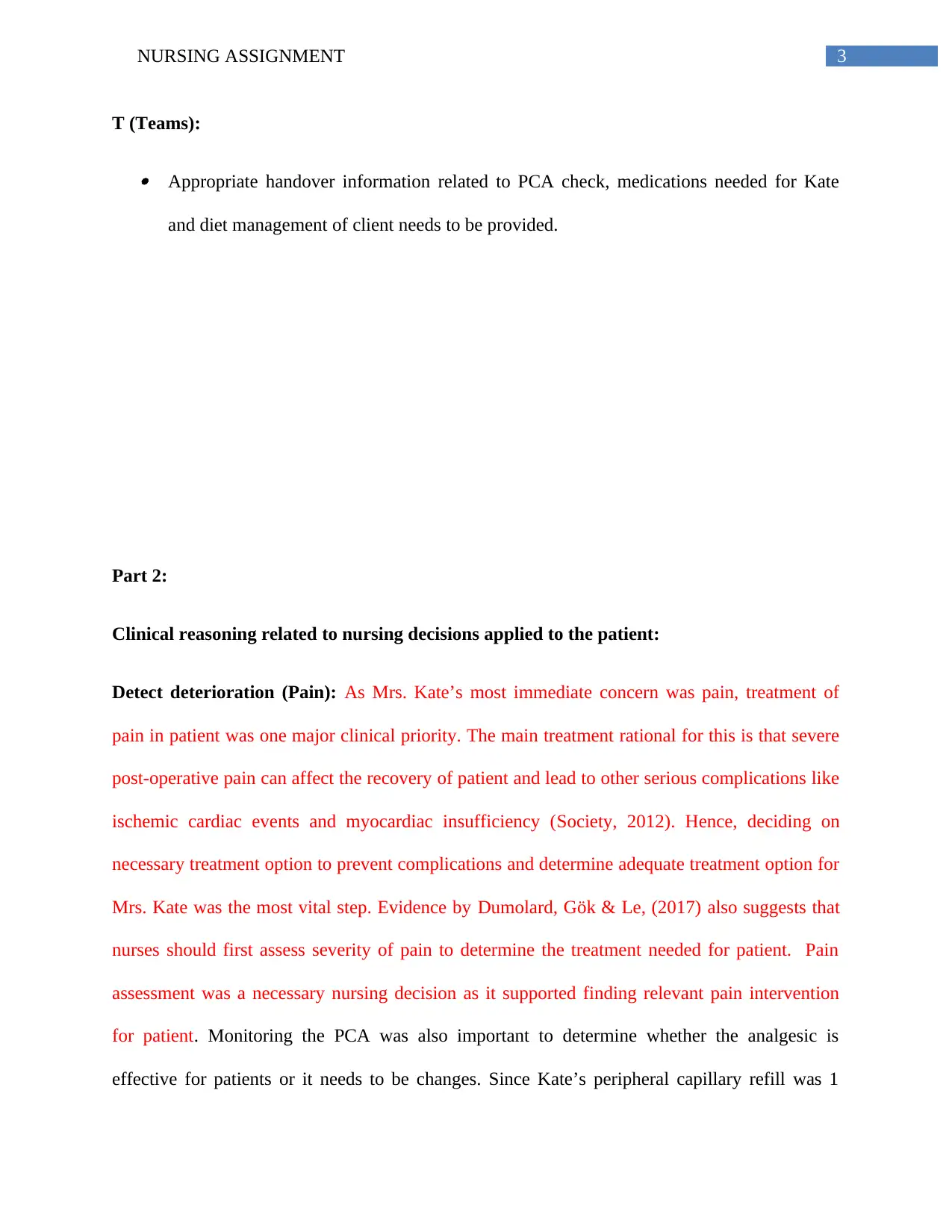
3NURSING ASSIGNMENT
T (Teams):
Appropriate handover information related to PCA check, medications needed for Kate
and diet management of client needs to be provided.
Part 2:
Clinical reasoning related to nursing decisions applied to the patient:
Detect deterioration (Pain): As Mrs. Kate’s most immediate concern was pain, treatment of
pain in patient was one major clinical priority. The main treatment rational for this is that severe
post-operative pain can affect the recovery of patient and lead to other serious complications like
ischemic cardiac events and myocardiac insufficiency (Society, 2012). Hence, deciding on
necessary treatment option to prevent complications and determine adequate treatment option for
Mrs. Kate was the most vital step. Evidence by Dumolard, Gök & Le, (2017) also suggests that
nurses should first assess severity of pain to determine the treatment needed for patient. Pain
assessment was a necessary nursing decision as it supported finding relevant pain intervention
for patient. Monitoring the PCA was also important to determine whether the analgesic is
effective for patients or it needs to be changes. Since Kate’s peripheral capillary refill was 1
T (Teams):
Appropriate handover information related to PCA check, medications needed for Kate
and diet management of client needs to be provided.
Part 2:
Clinical reasoning related to nursing decisions applied to the patient:
Detect deterioration (Pain): As Mrs. Kate’s most immediate concern was pain, treatment of
pain in patient was one major clinical priority. The main treatment rational for this is that severe
post-operative pain can affect the recovery of patient and lead to other serious complications like
ischemic cardiac events and myocardiac insufficiency (Society, 2012). Hence, deciding on
necessary treatment option to prevent complications and determine adequate treatment option for
Mrs. Kate was the most vital step. Evidence by Dumolard, Gök & Le, (2017) also suggests that
nurses should first assess severity of pain to determine the treatment needed for patient. Pain
assessment was a necessary nursing decision as it supported finding relevant pain intervention
for patient. Monitoring the PCA was also important to determine whether the analgesic is
effective for patients or it needs to be changes. Since Kate’s peripheral capillary refill was 1
Paraphrase This Document
Need a fresh take? Get an instant paraphrase of this document with our AI Paraphraser
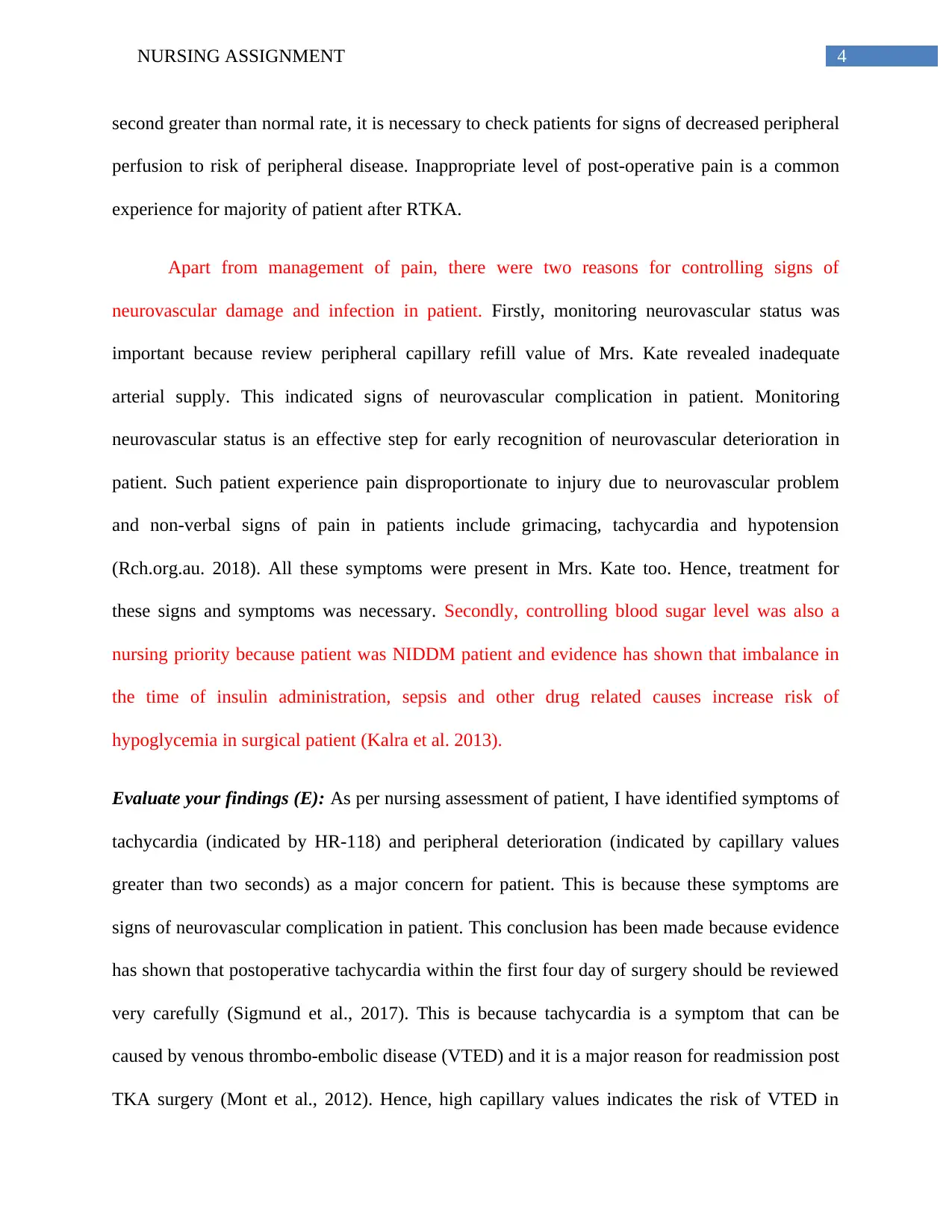
4NURSING ASSIGNMENT
second greater than normal rate, it is necessary to check patients for signs of decreased peripheral
perfusion to risk of peripheral disease. Inappropriate level of post-operative pain is a common
experience for majority of patient after RTKA.
Apart from management of pain, there were two reasons for controlling signs of
neurovascular damage and infection in patient. Firstly, monitoring neurovascular status was
important because review peripheral capillary refill value of Mrs. Kate revealed inadequate
arterial supply. This indicated signs of neurovascular complication in patient. Monitoring
neurovascular status is an effective step for early recognition of neurovascular deterioration in
patient. Such patient experience pain disproportionate to injury due to neurovascular problem
and non-verbal signs of pain in patients include grimacing, tachycardia and hypotension
(Rch.org.au. 2018). All these symptoms were present in Mrs. Kate too. Hence, treatment for
these signs and symptoms was necessary. Secondly, controlling blood sugar level was also a
nursing priority because patient was NIDDM patient and evidence has shown that imbalance in
the time of insulin administration, sepsis and other drug related causes increase risk of
hypoglycemia in surgical patient (Kalra et al. 2013).
Evaluate your findings (E): As per nursing assessment of patient, I have identified symptoms of
tachycardia (indicated by HR-118) and peripheral deterioration (indicated by capillary values
greater than two seconds) as a major concern for patient. This is because these symptoms are
signs of neurovascular complication in patient. This conclusion has been made because evidence
has shown that postoperative tachycardia within the first four day of surgery should be reviewed
very carefully (Sigmund et al., 2017). This is because tachycardia is a symptom that can be
caused by venous thrombo-embolic disease (VTED) and it is a major reason for readmission post
TKA surgery (Mont et al., 2012). Hence, high capillary values indicates the risk of VTED in
second greater than normal rate, it is necessary to check patients for signs of decreased peripheral
perfusion to risk of peripheral disease. Inappropriate level of post-operative pain is a common
experience for majority of patient after RTKA.
Apart from management of pain, there were two reasons for controlling signs of
neurovascular damage and infection in patient. Firstly, monitoring neurovascular status was
important because review peripheral capillary refill value of Mrs. Kate revealed inadequate
arterial supply. This indicated signs of neurovascular complication in patient. Monitoring
neurovascular status is an effective step for early recognition of neurovascular deterioration in
patient. Such patient experience pain disproportionate to injury due to neurovascular problem
and non-verbal signs of pain in patients include grimacing, tachycardia and hypotension
(Rch.org.au. 2018). All these symptoms were present in Mrs. Kate too. Hence, treatment for
these signs and symptoms was necessary. Secondly, controlling blood sugar level was also a
nursing priority because patient was NIDDM patient and evidence has shown that imbalance in
the time of insulin administration, sepsis and other drug related causes increase risk of
hypoglycemia in surgical patient (Kalra et al. 2013).
Evaluate your findings (E): As per nursing assessment of patient, I have identified symptoms of
tachycardia (indicated by HR-118) and peripheral deterioration (indicated by capillary values
greater than two seconds) as a major concern for patient. This is because these symptoms are
signs of neurovascular complication in patient. This conclusion has been made because evidence
has shown that postoperative tachycardia within the first four day of surgery should be reviewed
very carefully (Sigmund et al., 2017). This is because tachycardia is a symptom that can be
caused by venous thrombo-embolic disease (VTED) and it is a major reason for readmission post
TKA surgery (Mont et al., 2012). Hence, high capillary values indicates the risk of VTED in
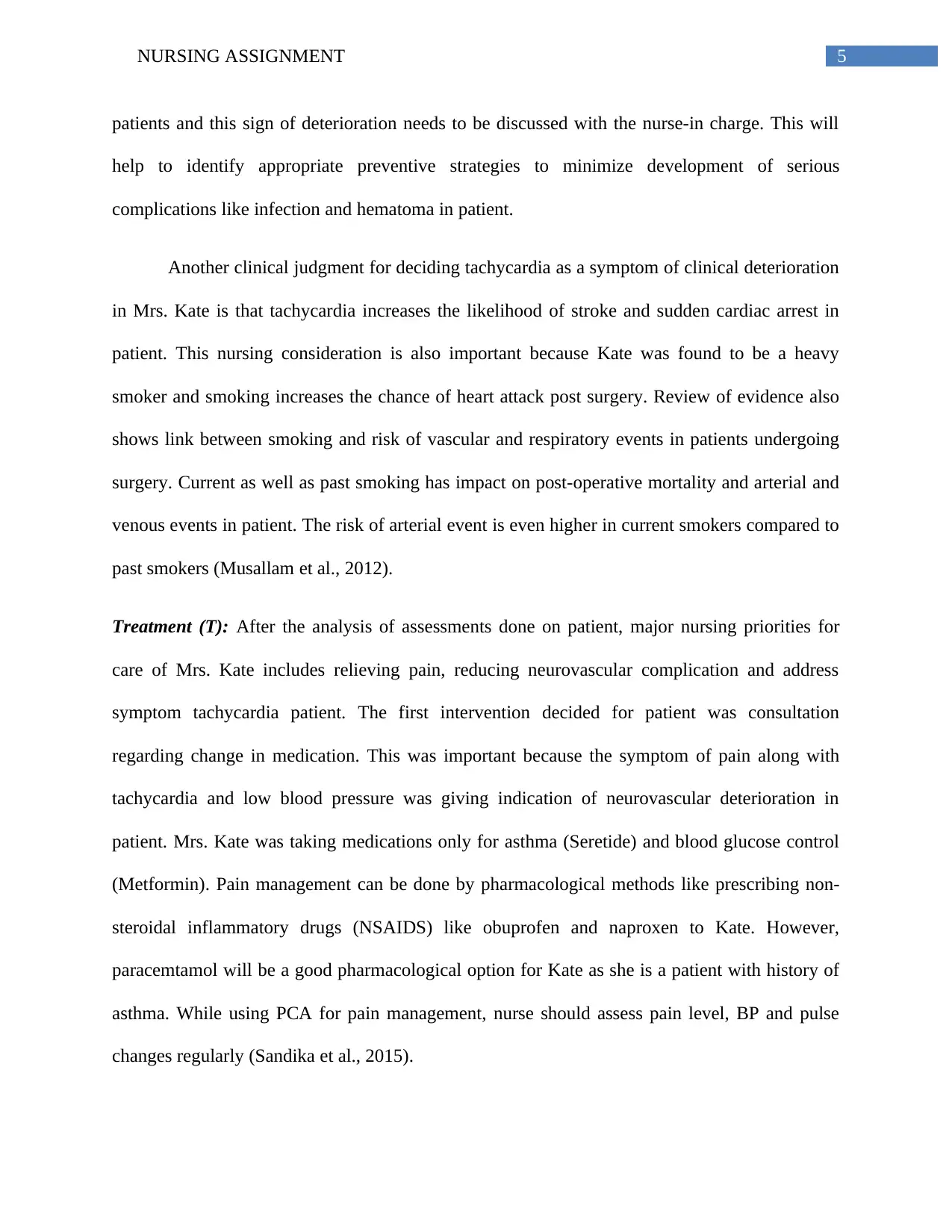
5NURSING ASSIGNMENT
patients and this sign of deterioration needs to be discussed with the nurse-in charge. This will
help to identify appropriate preventive strategies to minimize development of serious
complications like infection and hematoma in patient.
Another clinical judgment for deciding tachycardia as a symptom of clinical deterioration
in Mrs. Kate is that tachycardia increases the likelihood of stroke and sudden cardiac arrest in
patient. This nursing consideration is also important because Kate was found to be a heavy
smoker and smoking increases the chance of heart attack post surgery. Review of evidence also
shows link between smoking and risk of vascular and respiratory events in patients undergoing
surgery. Current as well as past smoking has impact on post-operative mortality and arterial and
venous events in patient. The risk of arterial event is even higher in current smokers compared to
past smokers (Musallam et al., 2012).
Treatment (T): After the analysis of assessments done on patient, major nursing priorities for
care of Mrs. Kate includes relieving pain, reducing neurovascular complication and address
symptom tachycardia patient. The first intervention decided for patient was consultation
regarding change in medication. This was important because the symptom of pain along with
tachycardia and low blood pressure was giving indication of neurovascular deterioration in
patient. Mrs. Kate was taking medications only for asthma (Seretide) and blood glucose control
(Metformin). Pain management can be done by pharmacological methods like prescribing non-
steroidal inflammatory drugs (NSAIDS) like obuprofen and naproxen to Kate. However,
paracemtamol will be a good pharmacological option for Kate as she is a patient with history of
asthma. While using PCA for pain management, nurse should assess pain level, BP and pulse
changes regularly (Sandika et al., 2015).
patients and this sign of deterioration needs to be discussed with the nurse-in charge. This will
help to identify appropriate preventive strategies to minimize development of serious
complications like infection and hematoma in patient.
Another clinical judgment for deciding tachycardia as a symptom of clinical deterioration
in Mrs. Kate is that tachycardia increases the likelihood of stroke and sudden cardiac arrest in
patient. This nursing consideration is also important because Kate was found to be a heavy
smoker and smoking increases the chance of heart attack post surgery. Review of evidence also
shows link between smoking and risk of vascular and respiratory events in patients undergoing
surgery. Current as well as past smoking has impact on post-operative mortality and arterial and
venous events in patient. The risk of arterial event is even higher in current smokers compared to
past smokers (Musallam et al., 2012).
Treatment (T): After the analysis of assessments done on patient, major nursing priorities for
care of Mrs. Kate includes relieving pain, reducing neurovascular complication and address
symptom tachycardia patient. The first intervention decided for patient was consultation
regarding change in medication. This was important because the symptom of pain along with
tachycardia and low blood pressure was giving indication of neurovascular deterioration in
patient. Mrs. Kate was taking medications only for asthma (Seretide) and blood glucose control
(Metformin). Pain management can be done by pharmacological methods like prescribing non-
steroidal inflammatory drugs (NSAIDS) like obuprofen and naproxen to Kate. However,
paracemtamol will be a good pharmacological option for Kate as she is a patient with history of
asthma. While using PCA for pain management, nurse should assess pain level, BP and pulse
changes regularly (Sandika et al., 2015).
⊘ This is a preview!⊘
Do you want full access?
Subscribe today to unlock all pages.

Trusted by 1+ million students worldwide
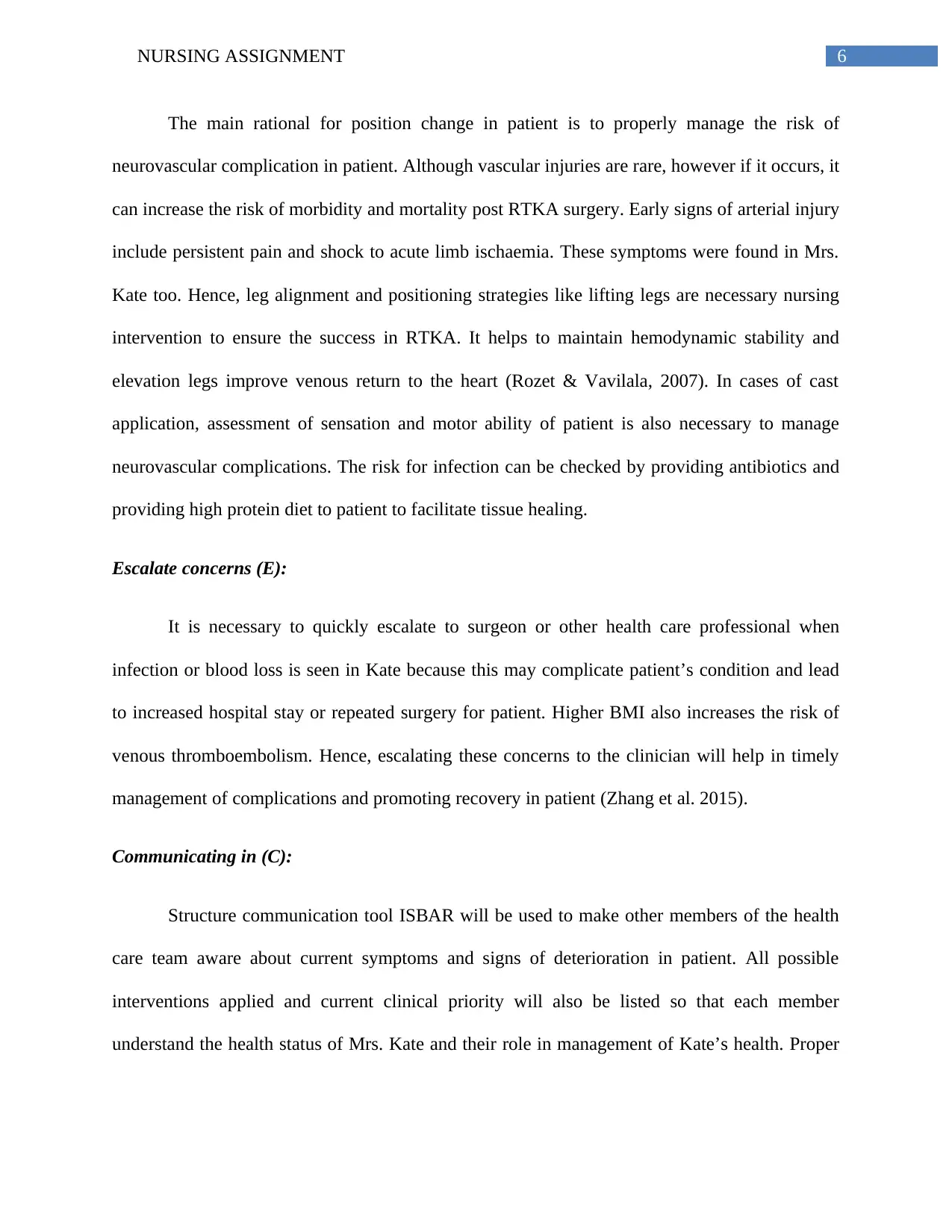
6NURSING ASSIGNMENT
The main rational for position change in patient is to properly manage the risk of
neurovascular complication in patient. Although vascular injuries are rare, however if it occurs, it
can increase the risk of morbidity and mortality post RTKA surgery. Early signs of arterial injury
include persistent pain and shock to acute limb ischaemia. These symptoms were found in Mrs.
Kate too. Hence, leg alignment and positioning strategies like lifting legs are necessary nursing
intervention to ensure the success in RTKA. It helps to maintain hemodynamic stability and
elevation legs improve venous return to the heart (Rozet & Vavilala, 2007). In cases of cast
application, assessment of sensation and motor ability of patient is also necessary to manage
neurovascular complications. The risk for infection can be checked by providing antibiotics and
providing high protein diet to patient to facilitate tissue healing.
Escalate concerns (E):
It is necessary to quickly escalate to surgeon or other health care professional when
infection or blood loss is seen in Kate because this may complicate patient’s condition and lead
to increased hospital stay or repeated surgery for patient. Higher BMI also increases the risk of
venous thromboembolism. Hence, escalating these concerns to the clinician will help in timely
management of complications and promoting recovery in patient (Zhang et al. 2015).
Communicating in (C):
Structure communication tool ISBAR will be used to make other members of the health
care team aware about current symptoms and signs of deterioration in patient. All possible
interventions applied and current clinical priority will also be listed so that each member
understand the health status of Mrs. Kate and their role in management of Kate’s health. Proper
The main rational for position change in patient is to properly manage the risk of
neurovascular complication in patient. Although vascular injuries are rare, however if it occurs, it
can increase the risk of morbidity and mortality post RTKA surgery. Early signs of arterial injury
include persistent pain and shock to acute limb ischaemia. These symptoms were found in Mrs.
Kate too. Hence, leg alignment and positioning strategies like lifting legs are necessary nursing
intervention to ensure the success in RTKA. It helps to maintain hemodynamic stability and
elevation legs improve venous return to the heart (Rozet & Vavilala, 2007). In cases of cast
application, assessment of sensation and motor ability of patient is also necessary to manage
neurovascular complications. The risk for infection can be checked by providing antibiotics and
providing high protein diet to patient to facilitate tissue healing.
Escalate concerns (E):
It is necessary to quickly escalate to surgeon or other health care professional when
infection or blood loss is seen in Kate because this may complicate patient’s condition and lead
to increased hospital stay or repeated surgery for patient. Higher BMI also increases the risk of
venous thromboembolism. Hence, escalating these concerns to the clinician will help in timely
management of complications and promoting recovery in patient (Zhang et al. 2015).
Communicating in (C):
Structure communication tool ISBAR will be used to make other members of the health
care team aware about current symptoms and signs of deterioration in patient. All possible
interventions applied and current clinical priority will also be listed so that each member
understand the health status of Mrs. Kate and their role in management of Kate’s health. Proper
Paraphrase This Document
Need a fresh take? Get an instant paraphrase of this document with our AI Paraphraser
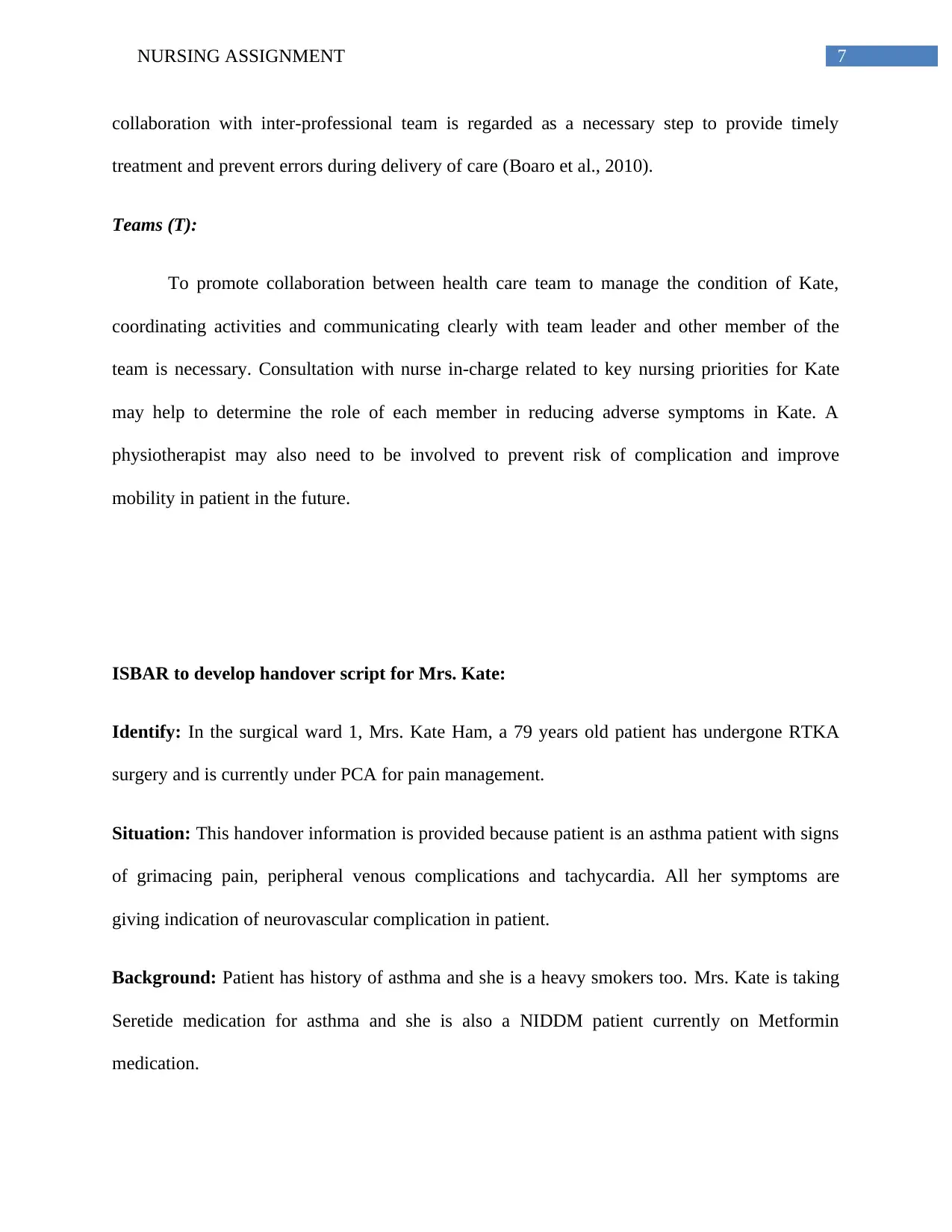
7NURSING ASSIGNMENT
collaboration with inter-professional team is regarded as a necessary step to provide timely
treatment and prevent errors during delivery of care (Boaro et al., 2010).
Teams (T):
To promote collaboration between health care team to manage the condition of Kate,
coordinating activities and communicating clearly with team leader and other member of the
team is necessary. Consultation with nurse in-charge related to key nursing priorities for Kate
may help to determine the role of each member in reducing adverse symptoms in Kate. A
physiotherapist may also need to be involved to prevent risk of complication and improve
mobility in patient in the future.
ISBAR to develop handover script for Mrs. Kate:
Identify: In the surgical ward 1, Mrs. Kate Ham, a 79 years old patient has undergone RTKA
surgery and is currently under PCA for pain management.
Situation: This handover information is provided because patient is an asthma patient with signs
of grimacing pain, peripheral venous complications and tachycardia. All her symptoms are
giving indication of neurovascular complication in patient.
Background: Patient has history of asthma and she is a heavy smokers too. Mrs. Kate is taking
Seretide medication for asthma and she is also a NIDDM patient currently on Metformin
medication.
collaboration with inter-professional team is regarded as a necessary step to provide timely
treatment and prevent errors during delivery of care (Boaro et al., 2010).
Teams (T):
To promote collaboration between health care team to manage the condition of Kate,
coordinating activities and communicating clearly with team leader and other member of the
team is necessary. Consultation with nurse in-charge related to key nursing priorities for Kate
may help to determine the role of each member in reducing adverse symptoms in Kate. A
physiotherapist may also need to be involved to prevent risk of complication and improve
mobility in patient in the future.
ISBAR to develop handover script for Mrs. Kate:
Identify: In the surgical ward 1, Mrs. Kate Ham, a 79 years old patient has undergone RTKA
surgery and is currently under PCA for pain management.
Situation: This handover information is provided because patient is an asthma patient with signs
of grimacing pain, peripheral venous complications and tachycardia. All her symptoms are
giving indication of neurovascular complication in patient.
Background: Patient has history of asthma and she is a heavy smokers too. Mrs. Kate is taking
Seretide medication for asthma and she is also a NIDDM patient currently on Metformin
medication.
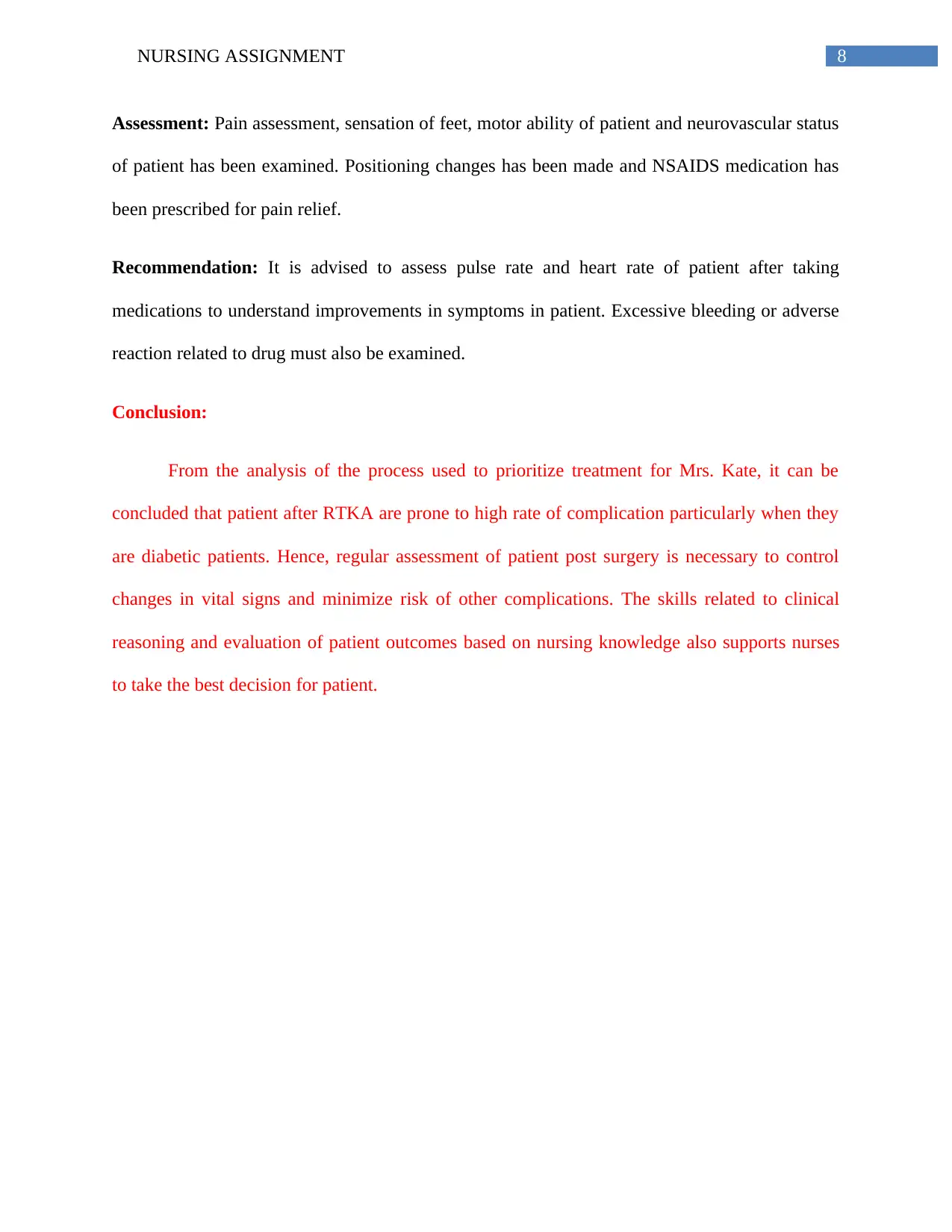
8NURSING ASSIGNMENT
Assessment: Pain assessment, sensation of feet, motor ability of patient and neurovascular status
of patient has been examined. Positioning changes has been made and NSAIDS medication has
been prescribed for pain relief.
Recommendation: It is advised to assess pulse rate and heart rate of patient after taking
medications to understand improvements in symptoms in patient. Excessive bleeding or adverse
reaction related to drug must also be examined.
Conclusion:
From the analysis of the process used to prioritize treatment for Mrs. Kate, it can be
concluded that patient after RTKA are prone to high rate of complication particularly when they
are diabetic patients. Hence, regular assessment of patient post surgery is necessary to control
changes in vital signs and minimize risk of other complications. The skills related to clinical
reasoning and evaluation of patient outcomes based on nursing knowledge also supports nurses
to take the best decision for patient.
Assessment: Pain assessment, sensation of feet, motor ability of patient and neurovascular status
of patient has been examined. Positioning changes has been made and NSAIDS medication has
been prescribed for pain relief.
Recommendation: It is advised to assess pulse rate and heart rate of patient after taking
medications to understand improvements in symptoms in patient. Excessive bleeding or adverse
reaction related to drug must also be examined.
Conclusion:
From the analysis of the process used to prioritize treatment for Mrs. Kate, it can be
concluded that patient after RTKA are prone to high rate of complication particularly when they
are diabetic patients. Hence, regular assessment of patient post surgery is necessary to control
changes in vital signs and minimize risk of other complications. The skills related to clinical
reasoning and evaluation of patient outcomes based on nursing knowledge also supports nurses
to take the best decision for patient.
⊘ This is a preview!⊘
Do you want full access?
Subscribe today to unlock all pages.

Trusted by 1+ million students worldwide
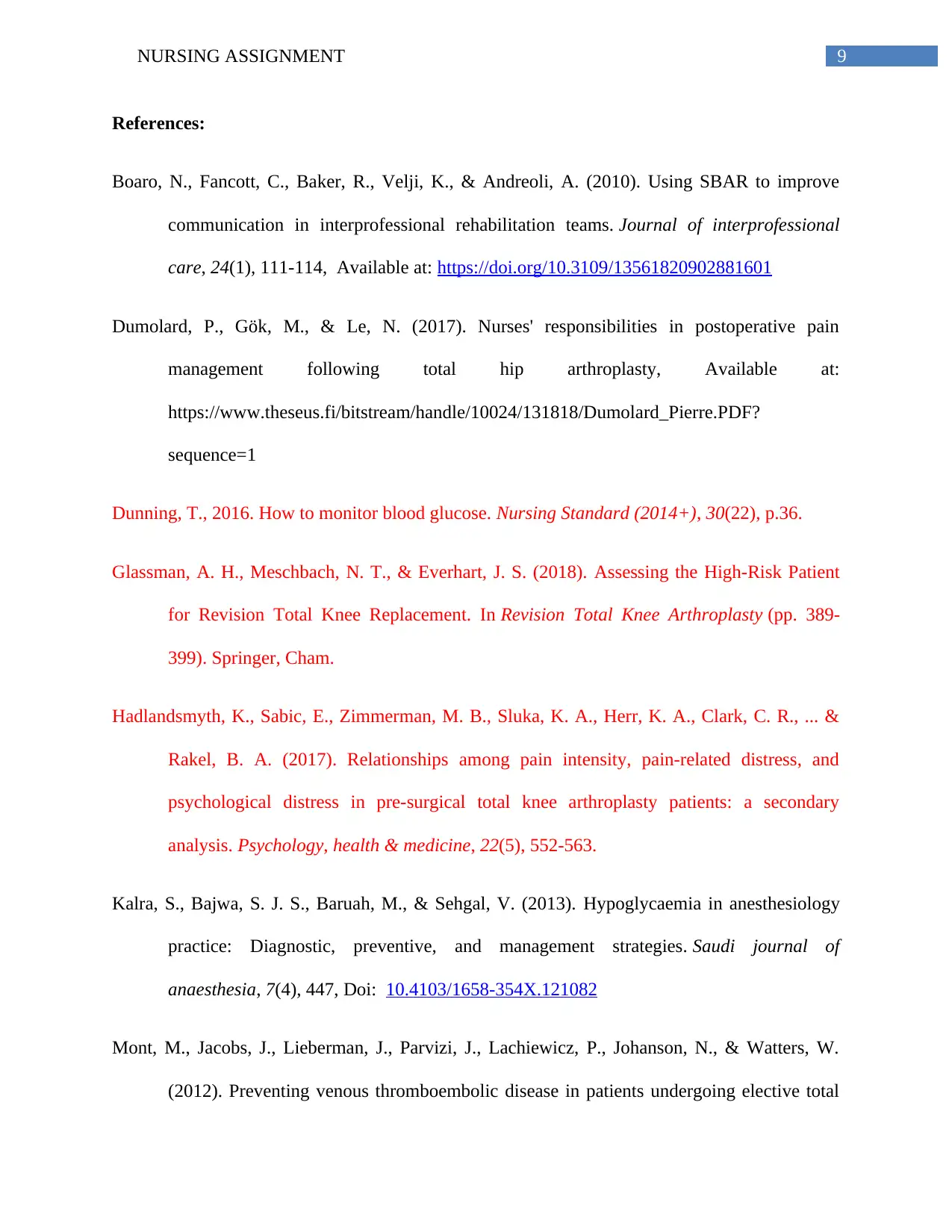
9NURSING ASSIGNMENT
References:
Boaro, N., Fancott, C., Baker, R., Velji, K., & Andreoli, A. (2010). Using SBAR to improve
communication in interprofessional rehabilitation teams. Journal of interprofessional
care, 24(1), 111-114, Available at: https://doi.org/10.3109/13561820902881601
Dumolard, P., Gök, M., & Le, N. (2017). Nurses' responsibilities in postoperative pain
management following total hip arthroplasty, Available at:
https://www.theseus.fi/bitstream/handle/10024/131818/Dumolard_Pierre.PDF?
sequence=1
Dunning, T., 2016. How to monitor blood glucose. Nursing Standard (2014+), 30(22), p.36.
Glassman, A. H., Meschbach, N. T., & Everhart, J. S. (2018). Assessing the High-Risk Patient
for Revision Total Knee Replacement. In Revision Total Knee Arthroplasty (pp. 389-
399). Springer, Cham.
Hadlandsmyth, K., Sabic, E., Zimmerman, M. B., Sluka, K. A., Herr, K. A., Clark, C. R., ... &
Rakel, B. A. (2017). Relationships among pain intensity, pain-related distress, and
psychological distress in pre-surgical total knee arthroplasty patients: a secondary
analysis. Psychology, health & medicine, 22(5), 552-563.
Kalra, S., Bajwa, S. J. S., Baruah, M., & Sehgal, V. (2013). Hypoglycaemia in anesthesiology
practice: Diagnostic, preventive, and management strategies. Saudi journal of
anaesthesia, 7(4), 447, Doi: 10.4103/1658-354X.121082
Mont, M., Jacobs, J., Lieberman, J., Parvizi, J., Lachiewicz, P., Johanson, N., & Watters, W.
(2012). Preventing venous thromboembolic disease in patients undergoing elective total
References:
Boaro, N., Fancott, C., Baker, R., Velji, K., & Andreoli, A. (2010). Using SBAR to improve
communication in interprofessional rehabilitation teams. Journal of interprofessional
care, 24(1), 111-114, Available at: https://doi.org/10.3109/13561820902881601
Dumolard, P., Gök, M., & Le, N. (2017). Nurses' responsibilities in postoperative pain
management following total hip arthroplasty, Available at:
https://www.theseus.fi/bitstream/handle/10024/131818/Dumolard_Pierre.PDF?
sequence=1
Dunning, T., 2016. How to monitor blood glucose. Nursing Standard (2014+), 30(22), p.36.
Glassman, A. H., Meschbach, N. T., & Everhart, J. S. (2018). Assessing the High-Risk Patient
for Revision Total Knee Replacement. In Revision Total Knee Arthroplasty (pp. 389-
399). Springer, Cham.
Hadlandsmyth, K., Sabic, E., Zimmerman, M. B., Sluka, K. A., Herr, K. A., Clark, C. R., ... &
Rakel, B. A. (2017). Relationships among pain intensity, pain-related distress, and
psychological distress in pre-surgical total knee arthroplasty patients: a secondary
analysis. Psychology, health & medicine, 22(5), 552-563.
Kalra, S., Bajwa, S. J. S., Baruah, M., & Sehgal, V. (2013). Hypoglycaemia in anesthesiology
practice: Diagnostic, preventive, and management strategies. Saudi journal of
anaesthesia, 7(4), 447, Doi: 10.4103/1658-354X.121082
Mont, M., Jacobs, J., Lieberman, J., Parvizi, J., Lachiewicz, P., Johanson, N., & Watters, W.
(2012). Preventing venous thromboembolic disease in patients undergoing elective total
Paraphrase This Document
Need a fresh take? Get an instant paraphrase of this document with our AI Paraphraser
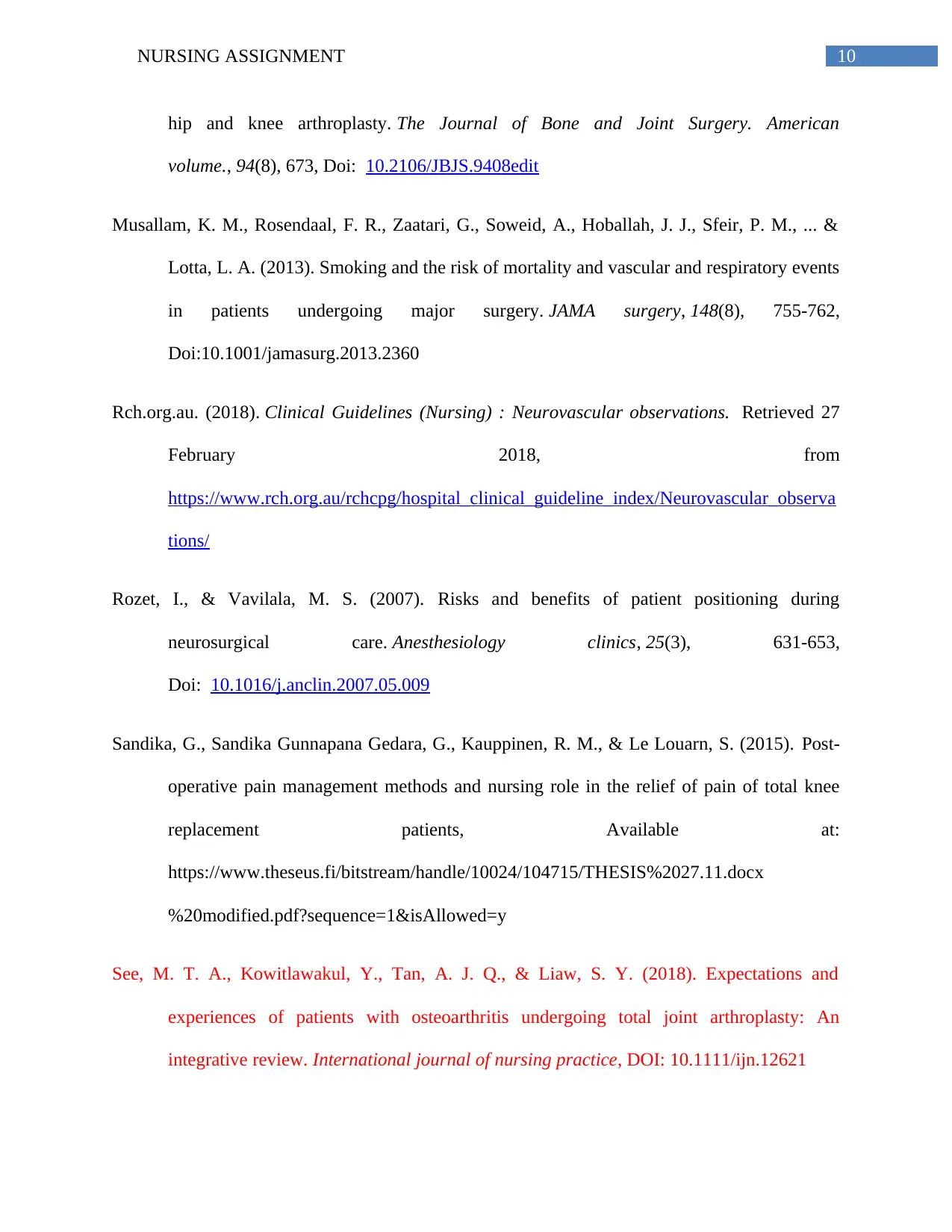
10NURSING ASSIGNMENT
hip and knee arthroplasty. The Journal of Bone and Joint Surgery. American
volume., 94(8), 673, Doi: 10.2106/JBJS.9408edit
Musallam, K. M., Rosendaal, F. R., Zaatari, G., Soweid, A., Hoballah, J. J., Sfeir, P. M., ... &
Lotta, L. A. (2013). Smoking and the risk of mortality and vascular and respiratory events
in patients undergoing major surgery. JAMA surgery, 148(8), 755-762,
Doi:10.1001/jamasurg.2013.2360
Rch.org.au. (2018). Clinical Guidelines (Nursing) : Neurovascular observations. Retrieved 27
February 2018, from
https://www.rch.org.au/rchcpg/hospital_clinical_guideline_index/Neurovascular_observa
tions/
Rozet, I., & Vavilala, M. S. (2007). Risks and benefits of patient positioning during
neurosurgical care. Anesthesiology clinics, 25(3), 631-653,
Doi: 10.1016/j.anclin.2007.05.009
Sandika, G., Sandika Gunnapana Gedara, G., Kauppinen, R. M., & Le Louarn, S. (2015). Post-
operative pain management methods and nursing role in the relief of pain of total knee
replacement patients, Available at:
https://www.theseus.fi/bitstream/handle/10024/104715/THESIS%2027.11.docx
%20modified.pdf?sequence=1&isAllowed=y
See, M. T. A., Kowitlawakul, Y., Tan, A. J. Q., & Liaw, S. Y. (2018). Expectations and
experiences of patients with osteoarthritis undergoing total joint arthroplasty: An
integrative review. International journal of nursing practice, DOI: 10.1111/ijn.12621
hip and knee arthroplasty. The Journal of Bone and Joint Surgery. American
volume., 94(8), 673, Doi: 10.2106/JBJS.9408edit
Musallam, K. M., Rosendaal, F. R., Zaatari, G., Soweid, A., Hoballah, J. J., Sfeir, P. M., ... &
Lotta, L. A. (2013). Smoking and the risk of mortality and vascular and respiratory events
in patients undergoing major surgery. JAMA surgery, 148(8), 755-762,
Doi:10.1001/jamasurg.2013.2360
Rch.org.au. (2018). Clinical Guidelines (Nursing) : Neurovascular observations. Retrieved 27
February 2018, from
https://www.rch.org.au/rchcpg/hospital_clinical_guideline_index/Neurovascular_observa
tions/
Rozet, I., & Vavilala, M. S. (2007). Risks and benefits of patient positioning during
neurosurgical care. Anesthesiology clinics, 25(3), 631-653,
Doi: 10.1016/j.anclin.2007.05.009
Sandika, G., Sandika Gunnapana Gedara, G., Kauppinen, R. M., & Le Louarn, S. (2015). Post-
operative pain management methods and nursing role in the relief of pain of total knee
replacement patients, Available at:
https://www.theseus.fi/bitstream/handle/10024/104715/THESIS%2027.11.docx
%20modified.pdf?sequence=1&isAllowed=y
See, M. T. A., Kowitlawakul, Y., Tan, A. J. Q., & Liaw, S. Y. (2018). Expectations and
experiences of patients with osteoarthritis undergoing total joint arthroplasty: An
integrative review. International journal of nursing practice, DOI: 10.1111/ijn.12621
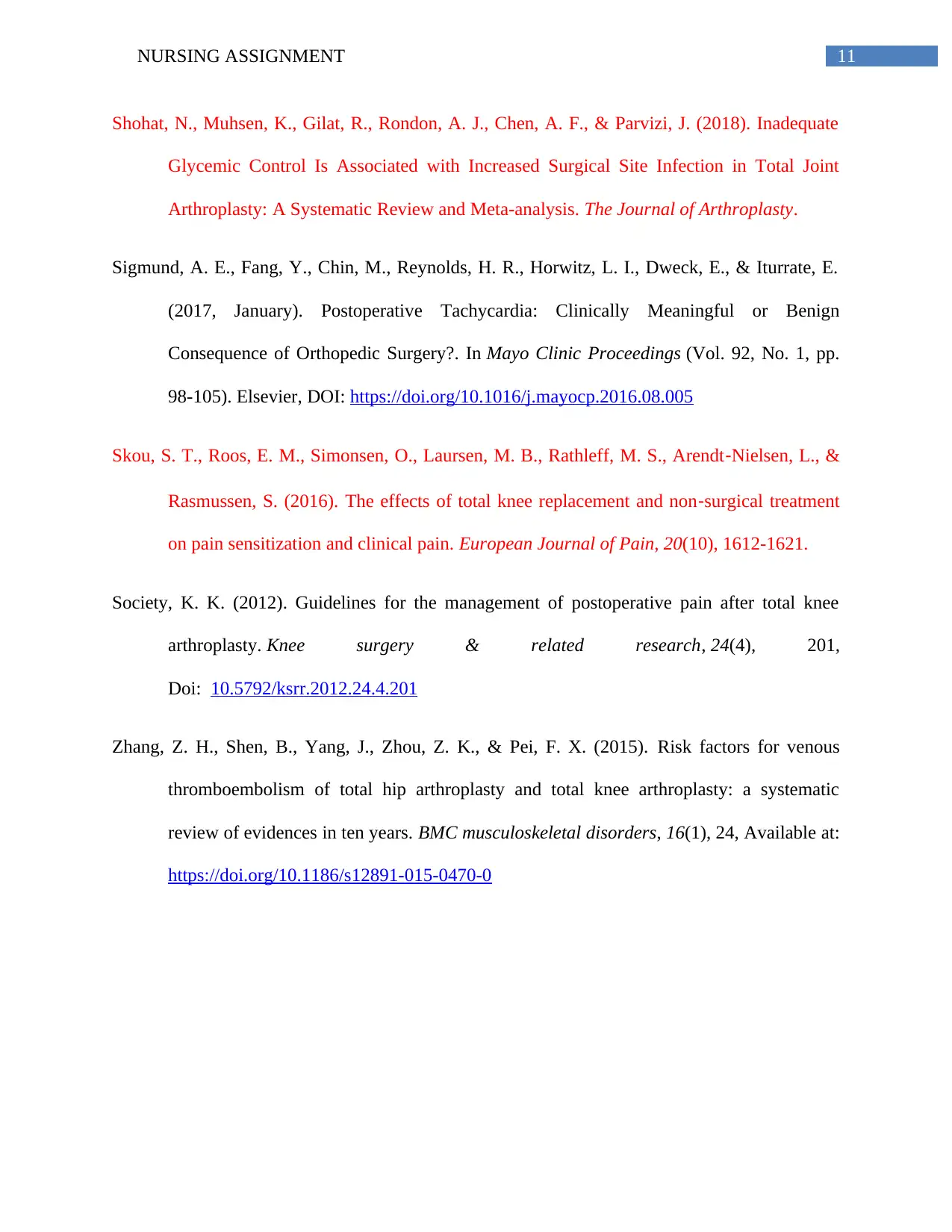
11NURSING ASSIGNMENT
Shohat, N., Muhsen, K., Gilat, R., Rondon, A. J., Chen, A. F., & Parvizi, J. (2018). Inadequate
Glycemic Control Is Associated with Increased Surgical Site Infection in Total Joint
Arthroplasty: A Systematic Review and Meta-analysis. The Journal of Arthroplasty.
Sigmund, A. E., Fang, Y., Chin, M., Reynolds, H. R., Horwitz, L. I., Dweck, E., & Iturrate, E.
(2017, January). Postoperative Tachycardia: Clinically Meaningful or Benign
Consequence of Orthopedic Surgery?. In Mayo Clinic Proceedings (Vol. 92, No. 1, pp.
98-105). Elsevier, DOI: https://doi.org/10.1016/j.mayocp.2016.08.005
Skou, S. T., Roos, E. M., Simonsen, O., Laursen, M. B., Rathleff, M. S., Arendt‐Nielsen, L., &
Rasmussen, S. (2016). The effects of total knee replacement and non‐surgical treatment
on pain sensitization and clinical pain. European Journal of Pain, 20(10), 1612-1621.
Society, K. K. (2012). Guidelines for the management of postoperative pain after total knee
arthroplasty. Knee surgery & related research, 24(4), 201,
Doi: 10.5792/ksrr.2012.24.4.201
Zhang, Z. H., Shen, B., Yang, J., Zhou, Z. K., & Pei, F. X. (2015). Risk factors for venous
thromboembolism of total hip arthroplasty and total knee arthroplasty: a systematic
review of evidences in ten years. BMC musculoskeletal disorders, 16(1), 24, Available at:
https://doi.org/10.1186/s12891-015-0470-0
Shohat, N., Muhsen, K., Gilat, R., Rondon, A. J., Chen, A. F., & Parvizi, J. (2018). Inadequate
Glycemic Control Is Associated with Increased Surgical Site Infection in Total Joint
Arthroplasty: A Systematic Review and Meta-analysis. The Journal of Arthroplasty.
Sigmund, A. E., Fang, Y., Chin, M., Reynolds, H. R., Horwitz, L. I., Dweck, E., & Iturrate, E.
(2017, January). Postoperative Tachycardia: Clinically Meaningful or Benign
Consequence of Orthopedic Surgery?. In Mayo Clinic Proceedings (Vol. 92, No. 1, pp.
98-105). Elsevier, DOI: https://doi.org/10.1016/j.mayocp.2016.08.005
Skou, S. T., Roos, E. M., Simonsen, O., Laursen, M. B., Rathleff, M. S., Arendt‐Nielsen, L., &
Rasmussen, S. (2016). The effects of total knee replacement and non‐surgical treatment
on pain sensitization and clinical pain. European Journal of Pain, 20(10), 1612-1621.
Society, K. K. (2012). Guidelines for the management of postoperative pain after total knee
arthroplasty. Knee surgery & related research, 24(4), 201,
Doi: 10.5792/ksrr.2012.24.4.201
Zhang, Z. H., Shen, B., Yang, J., Zhou, Z. K., & Pei, F. X. (2015). Risk factors for venous
thromboembolism of total hip arthroplasty and total knee arthroplasty: a systematic
review of evidences in ten years. BMC musculoskeletal disorders, 16(1), 24, Available at:
https://doi.org/10.1186/s12891-015-0470-0
⊘ This is a preview!⊘
Do you want full access?
Subscribe today to unlock all pages.

Trusted by 1+ million students worldwide
1 out of 13
Related Documents
Your All-in-One AI-Powered Toolkit for Academic Success.
+13062052269
info@desklib.com
Available 24*7 on WhatsApp / Email
![[object Object]](/_next/static/media/star-bottom.7253800d.svg)
Unlock your academic potential
Copyright © 2020–2025 A2Z Services. All Rights Reserved. Developed and managed by ZUCOL.



